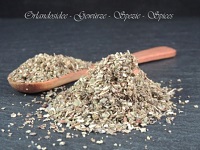
Sage leaves cut
Sage leaves cut from Italy — bold, aromatic & pleasantly bitter
Sage (Salvia officinalis) has a distinctive aromatic, spicy-bitter taste. Dried sage is more intense than fresh and is a staple of Mediterranean cooking, perfect with white meats, pan sauces and roasted vegetables.
- Botany: Salvia officinalis • Family: Lamiaceae
- Part used: leaves (dried, cut)
- Profile: resinous, camphoraceous, savory-bitter with warm herbal depth
- Best for: poultry & pork, butter sauces, gnocchi/pasta, beans, root veg, stuffing
Aroma & Taste
Concentrated evergreen-herbal notes with a clean, slightly bitter finish. A small pinch seasons deeply—dose lightly and build up to taste.
Culinary Uses
- Classic butter & pan sauces: brown butter with sage for gnocchi, ravioli or roast chicken; deglaze pans with broth or wine.
- Roasts & cutlets: rub onto pork or turkey with salt, pepper and lemon zest; great in breadcrumbs for schnitzel-style crusts.
- Vegetables & beans: roast pumpkin, potatoes, carrots or beans with sage and olive oil.
- Stuffings & breads: fold a pinch into bread stuffing or focaccia.
How to Use
- Bloom in fat: warm briefly in olive oil or butter (10–20 s) to release aroma.
- Timing: add early for long-cooked dishes; for butter sauces, perfume off-heat to avoid bitterness.
- Fresh ↔ dried guide: about 1 tsp dried ≈ 1 Tbsp fresh (3× by volume).
- Chop/crush fine: rub dried leaves between fingers or chop for even distribution.
Dosage & Kitchen Ratios
- Rubs/roasts: 1/2–1 tsp dried per 500 g (1.1 lb) meat or vegetables.
- Butter/pan sauces: 1/4–1/2 tsp dried per 250 ml (1 cup) sauce base.
- Stuffings/breads: 1–2 tsp dried per 500 g dough or mix.
Pairings
Sage pairs beautifully with rosemary, savory, marjoram, basil, garlic, ginger and onion; with butter, lemon zest/juice, white wine and olive oil.
Ingredients & Allergens
Ingredients: Sage leaves (Salvia officinalis), dried and cut.
Allergens: none mandatory in EN labeling for this single ingredient.
Storage & Shelf Life
Store airtight, cool, dry and away from light. Best aroma within 12–18 months. Reseal promptly after use.
Substitutes & Notes
Closest swaps: rosemary (piney; use less) or marjoram (softer, sweeter; use more). Balance sage’s intensity with citrus or dairy in rich dishes.
FAQ
Why did my sage taste bitter?
Overheating in fat or using too much can emphasize bitterness—use a light hand and add off-heat for delicate sauces.
Can I use dried sage instead of fresh?
Yes. Use roughly 1 tsp dried for 1 Tbsp fresh and adjust to taste.
Should I strain sage from sauces?
For smooth sauces, infuse whole leaves and remove; for rustic dishes, use finely crushed leaves.
Merchant contact: Orlandosidee — Spice Shop (see site imprint for full company details). Email: info(at)orlandosidee.de



